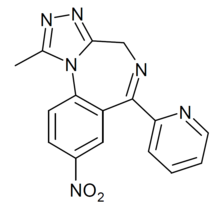 | |
| Identifiers | |
|---|---|
IUPAC name
| |
| CAS Number | |
| PubChem CID | |
| ChemSpider | |
| Chemical and physical data | |
| Formula | C16H12N6O2 |
| Molar mass | 320.312 g·mol |
| 3D model (JSmol) | |
SMILES
| |
InChI
| |
Pynazolam is a triazolobenzodiazepine derivative first invented in the 1970s, which has in more recent years been sold online as a designer drug. Anecdotal reports and in silico studies suggest it has relatively potent hypnotic and sedative effects. Pynazolam is a powerful serotonin releaser similar to nimetazepam which increases hypnotic activity and euphoria. Anecdotal evidence has also suggested that it's subjective effects are similar to methaqualone although unlike methaqualone, it cannot be smoked or vaporised due to its high melting & boiling point.
Limited pharmacological data is available although there is an increasing availability of the compound for research purposes.
See also
References
- US 3970664, Sternbach LH, Walser A, "Preparation of triazolo benzodiazepines.", issued 20 July 1976, assigned to Hoffmann-LaRoche, Inc.
- Pranzatelli, Michael R. (1989). "Benzodiazepine-induced shaking behavior in the rat: Structure-activity and relation to serotonin and benzodiazepine receptors". Experimental Neurology. 104 (3): 241–250. doi:10.1016/0014-4886(89)90036-8.
- https://bluelight.org/xf/threads/flubromazolam-retrospective-6-years-with-the-knockout-night-nurse.892802/page-7
- Catalani V, Floresta G, Botha M, Corkery JM, Guirguis A, Vento A, et al. (January 2023). "In silico studies on recreational drugs: 3D quantitative structure activity relationship prediction of classified and de novo designer benzodiazepines". Chemical Biology & Drug Design. 101 (1): 40–51. doi:10.1111/cbdd.14119. hdl:2299/25749. PMID 35838189.
- https://pubchem.ncbi.nlm.nih.gov/compound/20368157
| GABAA receptor positive modulators | |
|---|---|
| Alcohols | |
| Barbiturates |
|
| Benzodiazepines |
|
| Carbamates | |
| Flavonoids |
|
| Imidazoles | |
| Kava constituents | |
| Monoureides | |
| Neuroactive steroids |
|
| Nonbenzodiazepines | |
| Phenols | |
| Piperidinediones | |
| Pyrazolopyridines | |
| Quinazolinones | |
| Volatiles/gases |
|
| Others/unsorted |
|
| See also: Receptor/signaling modulators • GABA receptor modulators • GABA metabolism/transport modulators | |
This sedative-related article is a stub. You can help Misplaced Pages by expanding it. |